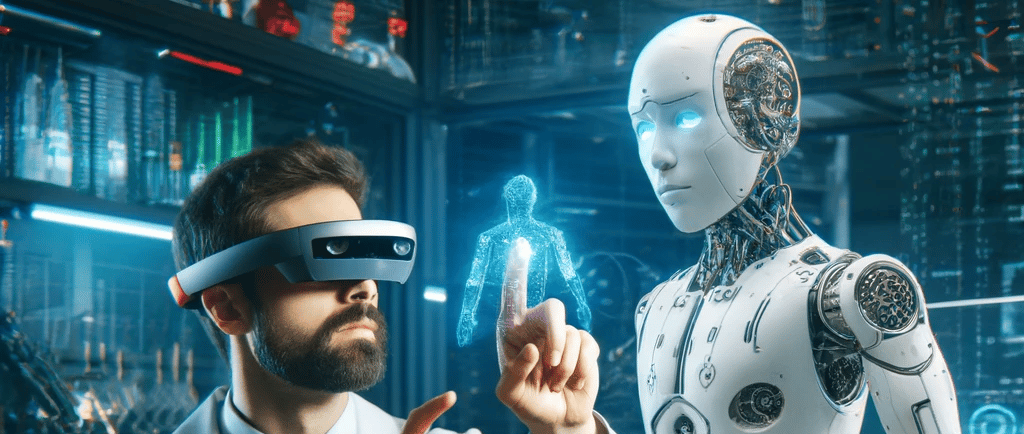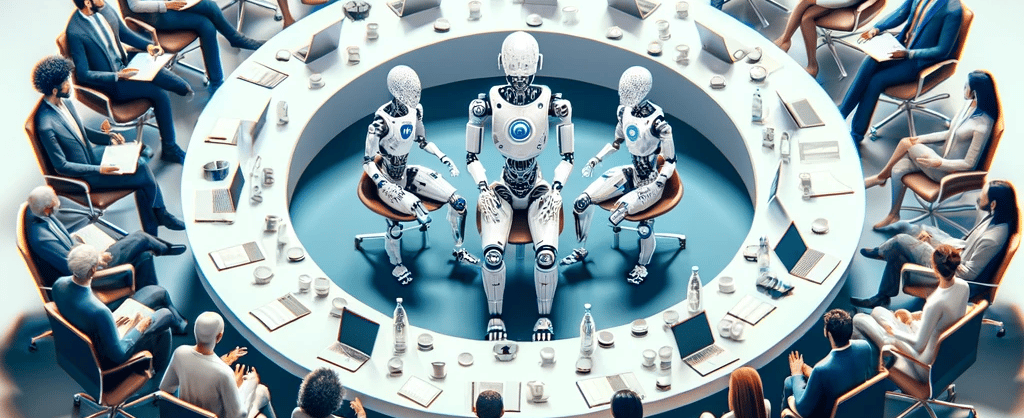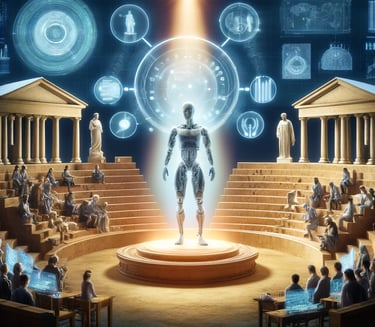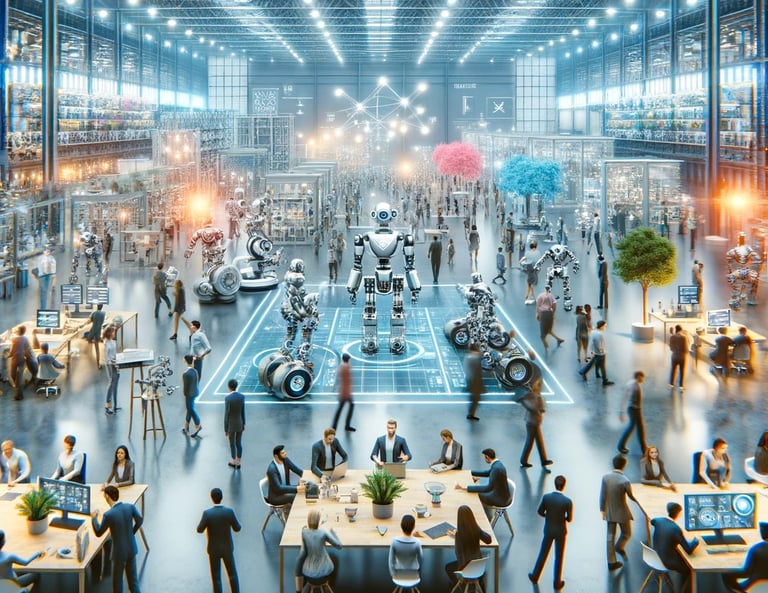Harmonizing Human Potential with Humanoid Robotics
Blog post description.
AI BLOGS


Harmonizing Human Potential with Humanoid Robotics
Humanoid robotics and artificial intelligence stand at the precipice of transforming our world in ways reminiscent of past technological revolutions—yet, with an unprecedented potential for both creation and disruption. The journey of these technologies, especially in the past year, showcases a vibrant tapestry of innovation, ambition, and an urgent need for strategic foresight.
At the heart of this transformative wave are major tech giants and ambitious startups channelling vast resources into the development of humanoid robots, which are increasingly becoming more than just the figments of science fiction. Companies like Tesla and Microsoft have recently made substantial investments, propelling the field forward. Tesla's Optimus project, for instance, is not just a technological endeavour; it embodies a vision where robots could one day assist in tasks ranging from mundane household chores to complex industrial operations (StartUs Insights).
However, amidst this rapid development, a critical piece remains conspicuously absent—a cohesive strategy that guides these technological advances towards enhancing human society sustainably. While individual companies push the boundaries of what's possible, the broader implications of their inventions on employment, ethics, and social structures linger as afterthoughts. This lack of a unified approach could lead to scenarios where technological capabilities outpace the frameworks we have in place to manage them responsibly (Techopedia).
Augmented reality (AR) presents a compelling solution to bridge this gap. By integrating AR with robotics, we can create an interactive layer that allows humans to control and collaborate with robots in real-time. This not only amplifies the capabilities of both but also ensures that these technologies complement human workers instead of displacing them. Imagine a world where surgeons use AR to control robotic arms for precise surgeries or disaster response teams deploy robots remotely to save lives in hazardous environments (MIT Technology Review).
As we navigate this new era, it is crucial to weave together technology, policy, and public engagement to ensure that the dance between human potential and robotic capabilities unfolds in harmony, enhancing each step towards a future that values both innovation and the human touch.
The Unfolding Challenges of Humanoid Robotics
The rapid acceleration of humanoid robotics, while promising, brings to light significant challenges that need addressing to ensure these technologies contribute positively and equitably to society.
Technological and Ethical Challenges:
The development of humanoid robots introduces complex technological challenges, particularly around the sophistication needed for robots to interact safely and effectively in human environments. The human-like movements and decision-making processes required for these robots necessitate advanced AI capabilities, which in turn raise profound ethical questions. For instance, as robots become more autonomous, the delineation of responsibility for their actions becomes blurred, posing questions about accountability and moral responsibility (StartUs Insights).
Additionally, the integration of these robots into daily life challenges our current legal and ethical frameworks. Should a robot have rights? What regulations are necessary to ensure privacy and security when robots can observe and learn from human behaviour? These questions are not just hypothetical but are pressing issues that require concerted efforts from policymakers, technologists, and ethicists to resolve.
Social and Economic Impact:
The potential for humanoid robots to impact the job market significantly is one of the most tangible and immediate concerns. As robots become capable of performing tasks traditionally done by humans, from driving trucks to providing customer service, the risk of job displacement increases. While some view this technological evolution as a means to alleviate humans from mundane tasks, others fear a future where human labour becomes obsolete (Techopedia).
The economic implications are vast and varied. On one hand, robots can boost productivity and efficiency, contributing to economic growth and creating new types of jobs in tech and robot maintenance. On the other hand, if not managed wisely, the shift could exacerbate existing inequalities, leaving those without the skills to transition into new roles vulnerable and economically disadvantaged.
The Need for a Strategic Approach
This landscape of challenges underscores the need for a strategic approach to the development and integration of humanoid robots. A unified strategy would not only address the technological and ethical challenges but also consider the socio-economic impacts, ensuring that the benefits of robotics advancements are distributed equitably across society.
Navigating the Integration of Humanoid Robotics
As we confront the challenges posed by the rapid advancement of humanoid robotics, several innovative solutions have been implemented to mitigate risks and maximize benefits. These approaches demonstrate a proactive stance in harnessing the potential of humanoid robots while addressing the pressing concerns they bring.
1. Ethical AI Development:
Leading organizations and research institutions are prioritizing the development of ethical guidelines for AI and robotics. These guidelines aim to ensure that robots are designed with ethical considerations at their core, promoting transparency, accountability, and fairness in their operations. Efforts such as the IEEE's Ethically Aligned Design initiative reflect a growing consensus on the importance of ethical standards in robotics (StartUs Insights).
2. Public-Private Partnerships:
Governments and private companies are increasingly collaborating to regulate and guide the development of humanoid robotics. These partnerships help balance innovation with societal needs, ensuring that robotics technologies are developed in a manner that respects public welfare and safety. Examples include advisory panels and regulatory frameworks that both stimulate technological advances and protect public interests.
3. Education and Workforce Reskilling:
In response to the potential job displacement caused by robotics, educational programs and reskilling initiatives have been launched to prepare the workforce for the changing job landscape. These programs are designed to equip individuals with the skills necessary to thrive in a robotics-enhanced world, focusing on areas like robotics maintenance, AI management, and other tech-driven fields.
4. Human-Robot Collaboration Models:
Some companies are exploring models where humans and robots collaborate rather than compete. These collaborative robots, or "co-bots," are designed to work alongside human workers, enhancing their capabilities and productivity without replacing them. This approach not only preserves jobs but also improves job quality and safety by offloading dangerous or repetitive tasks to robots.
5. Augmented Reality Interfaces:
Augmented reality (AR) is being leveraged to create interfaces that allow humans to intuitively control and interact with robots. By overlaying digital information onto the real world, AR interfaces enable operators to guide robots in complex tasks, enhancing the synergy between human dexterity and robotic precision. This technology not only reduces the risk of job displacement but also opens up new avenues for human-robot interaction in industries ranging from healthcare to construction (MIT Technology Review).
Unveiling Insights from Research and History
The deployment and integration of humanoid robotics into various sectors have prompted an in-depth examination of their impacts, from historical analogies to cutting-edge research. Here, we delve into specific insights that guide our understanding and approach to these technological advancements.
Innovations and Limitations:
Historically, the introduction of transformative technologies has often been met with both awe and anxiety. Just as the industrial revolution reshaped society, so too does the rise of humanoid robotics promise to redefine modern living. Research indicates that while robots excel in precision and repeatability, their ability to adapt to unpredictable environments is still under development. This dichotomy highlights the need for ongoing research to enhance robot autonomy while ensuring they complement human skills and creativity.
Ethical Considerations:
Studies underscore the ethical dilemmas posed by humanoid robots, especially in terms of decision-making and privacy. The capability of robots to learn from their environments and make autonomous decisions can lead to ethical challenges, particularly when these decisions impact human well-being. Ongoing debates in academia and industry discuss the establishment of universal ethical standards for robots, similar to Asimov's fictional laws of robotics, which dictate that a robot must not harm humans, must obey orders, and must protect its own existence in that order.
Socio-economic Impacts:
Research from leading economic institutions suggests that while humanoid robots can significantly boost productivity, they also pose risks of exacerbating income inequality. This is particularly evident in sectors where automation could replace low-skill jobs, thus displacing a significant portion of the workforce. To counterbalance this, studies recommend policies that encourage innovation while also safeguarding workers, such as minimum income schemes or enhanced vocational training programs.
Cultural and Social Dynamics:
Humanoid robots are not merely technological entities; they also exist within a social context that shapes and is shaped by their presence. Research from cultural studies illustrates how robots have been integrated into popular media and public consciousness, often reflecting societal fears and aspirations about technology. Understanding these cultural dimensions is crucial for designing humanoid robots that are accepted and beneficial within their intended communities.
Proposing a Path Forward with Humanoid Robotics
As we navigate the complexities introduced by humanoid robotics, it becomes imperative to adopt strategic measures that not only harness their potential but also mitigate associated risks. Here, we outline three major recommendations aimed at fostering a sustainable and beneficial integration of humanoid robotics into society.
1. Establish a Global Robotics Ethics Commission
Given the international impact and rapid development of robotics technology, establishing a global commission dedicated to the ethical issues surrounding humanoid robots is crucial. This body would work towards international standards and regulations, focusing not only on how robots should operate but also how they should be programmed to make decisions. It would facilitate global cooperation and ensure that ethical considerations are uniformly applied, preventing a patchwork of standards that could lead to ethical dilemmas and inconsistencies.
2. Implement a Universal Reskilling Initiative:
To address the job displacement risks associated with humanoid robots, a universal reskilling initiative should be launched. This program would provide training and education opportunities for workers in industries most likely to be affected by automation. By focusing on future-proof skills such as AI literacy, robotics maintenance, and digital competency, the initiative would help the workforce transition into new roles within the evolving technological landscape. Furthermore, it would promote a culture of lifelong learning, ensuring that all segments of society can adapt to and benefit from technological advancements.
3. Develop Public-Private Innovation Hubs:
To stimulate innovation while ensuring that the development of humanoid robotics aligns with societal needs, the creation of public-private innovation hubs is recommended. These hubs would serve as collaborative spaces where technology companies, researchers, government agencies, and the public can come together to develop and test robotic solutions. By fostering a collaborative environment, these hubs would not only accelerate the development of beneficial technologies but also ensure that these advancements are attuned to the public’s needs and concerns.
Steering the Future of Humanoid Robotics
As we stand at the crossroads of an era defined by rapid technological progress and complex societal challenges, the path forward with humanoid robotics requires thoughtful navigation and proactive leadership. The integration of these advanced technologies into our daily lives holds immense promise but also presents significant risks that must be managed with care and foresight.
Embracing a Future Enhanced by Robotics:
Humanoid robots, equipped with capabilities that extend human efforts, can lead to groundbreaking advancements in healthcare, disaster response, and everyday convenience. However, their potential can only be fully realized if we address the ethical, social, and economic challenges they bring. By implementing the suggested measures—establishing a global robotics ethics commission, launching a universal reskilling initiative, and creating public-private innovation hubs—we can ensure that these technologies benefit all segments of society.
A Call to Collective Action:
The future of humanoid robotics should not be shaped by technological determinism but by a collective vision that prioritizes human welfare and societal enhancement. We invite policymakers, technologists, and the global community to engage in this dialogue, contribute to the development of responsible robotics, and help steer this technology towards outcomes that uplift rather than unsettle.
Promoting Sustainability and Equity:
As we advance, let us remain vigilant in ensuring that the integration of robotics into our world is done in ways that promote sustainability and equity. This means not only advancing technological capabilities but also strengthening the social structures that support a just and equitable society.
In conclusion, the journey with humanoid robotics is not merely about innovation but about the opportunity to redefine the essence of human collaboration, productivity, and creativity. Let us move forward with the resolve to harness these technologies for the greater good, ensuring that as we step into the future, we do so together, with every member of society empowered by the possibilities that humanoid robotics bring.










